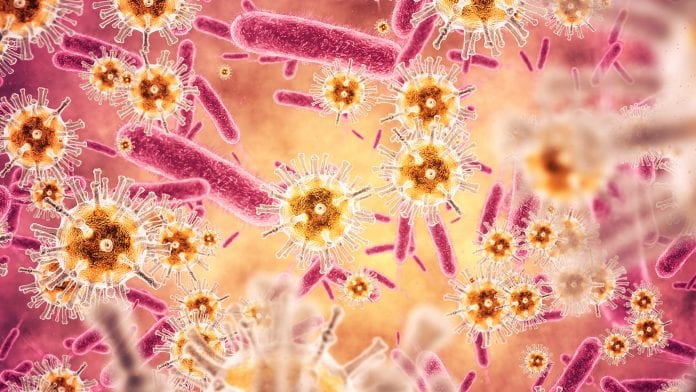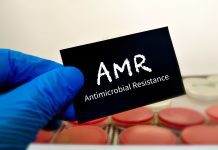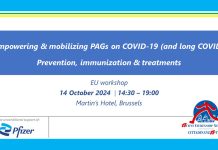
Pierre Meulien, Executive Director of Innovative Medicines Initiative, discusses the urgency of multisectoral care in treating drug-resistant infections.
While great strides have been made in the field of modern medicine, a growing threat that, worryingly, appears to be ever more resilient to advanced medical treatments is drug-resistant bacteria. While the World Health Organization (WHO) ranks antimicrobial resistance (AMR) within its top 10 global public health threats, lack of legislation and multisectoral initiatives to help combat this problem are desperately lacking. High costs associated with research and development of new antimicrobial medicines, as well as disparities between national healthcare systems, mean that antimicrobial-resistant organisms – which can be found in people, animals and the environment – are becoming increasingly widespread; and the drugs used to treat them are growing more ineffective.
While vaccines could offer a long-term solution for rendering bacteria-induced infections inert, problems arise when trying to decipher the most threatening infections and strains to treat, as well as designing relevant clinical trials to support this. In 2019, for instance, WHO identified 32 antibiotics in clinical development that addressed the organisation’s list of ‘priority pathogens’ – bacteria which poses the greatest threat to human health – and of those 32, only six were classed as innovative.
Inevitably, the COVID-19 pandemic has only exacerbated this threat, with patients unable to access the necessary care they need and facing the ongoing risk of contracting hospital-acquired infections if they are receiving treatment for COVID-related issues. The economic disparities associated with AMR also mean those living in economically deprived areas do not have access to essential healthcare facilities and treatments, and could be more susceptible to viruses if there is a lack of infection prevention and control systems.
Additionally, so-called ‘superbugs’, which denote the spreading of multi- and pan-resistant bacteria, are also becoming more common and can instigate the spread of additional infections that are difficult to treat with current antibiotics. The knock-on effect of unregulated treatments and lack of funding for AMR research makes every person, plant and animal more and more susceptible to the prevalence of these increasingly untreatable diseases, and if nothing is done, it will only get worse.
Pierre Meulien is the Executive Director of Innovative Medicines Initiative (IMI), an EU public-private partnership working to improve, and facilitate patient access to, innovative medicines by funding research and development in healthcare innovation. To date, the organisation has invested €800m to support AMR research.
He speaks to HEQ Junior Editor Lorna Malkin about the urgency of finding a sustainable solution for managing and treating antimicrobial-resistant infections.
What are the primary challenges facing the management and treatment of drug-resistant infections?
The challenges surrounding AMR have not really changed over the past decade. The greatest issue we are facing today is that we are running out of treatment interventions for those people who are unlucky enough to acquire a multi-drug resistant infection. Our aim therefore is really to try and increase the pipeline of antimicrobials to effectively treat these infections and alleviate this growing issue. Of course, we know that these bacteria are very good at building resistance if they are exposed to large amounts of antibiotics, so managing this on a global level means we need to address issues around policy and look at how we can implement a holistic, One Health approach. AMR is extremely complex: there is not one thing that will suddenly fix this issue, but at the same time the issue is not going away.
The basic challenge is still that we do not have any new interventions to go on, so we really need to work on researching and developing new antimicrobial treatments. We also need to work on other therapeutic interventions – maybe monoclonal antibodies, maybe vaccines – and anything else that may be beneficial. One of the main ways drug-resistant pathogens spread is in hospital environments, about 70% of these infections occur in hospital settings. Patients going into hospital for other treatments or surgery can be confronted with these additional, very serious complications, and so this is extremely challenging. This also relates to the challenges we face around clinical trials and knowing which drug-resistant bacteria or infection strain we need to target.
How can the disparities in the management of drug-resistant infections across human, animal and environmental health be better unified?
I think this really relates to management and stewardship. We talk about ‘stewardship of antibiotics’, whereby we measure the way in which antibiotics are prescribed and how this could be improved, and I think that the ways antibiotics are used in medicine, food production and more generally, released into the environment, through animal waste for instance, are all very different. Therefore, we need to establish a more joined-up approach and align incentives to try and diminish the amount and variety of antibiotics that are being put into the environment.
Antibiotics can be distributed through various agricultural and veterinary practices and there are huge productivity gains in animal health in using these antibiotics in animal foodstuffs, so it is a very complex issue. There needs to be greater connected thinking, and then connected agreement on how people are going to change behaviours and practices. I think the idea of this holistic approach is an excellent one; and that is where the European Union and European Commission can really play a huge role in policymaking, because they have the ability to go across these agricultural environments and health areas and their action plan is totally aligned.
Of course, we know that these are not things you can do overnight. There is no doubt that a One Health approach is the way to go; the only complication is how do you actually do that. How do you implement different incentives for people on the ground to encourage them to change their behaviour?
How can push and pull incentives be used to encourage pharmaceutical companies, academics, clinicians etc. to invest in antimicrobial research and development? How can these be sustainably financed?
Push incentives are one part that I think we are doing quite successfully. This is why a public-private partnership like the Innovative Medicines Initiative is ideal for this kind of thing, because we ‘de-risk’ certain elements that the companies maybe would not do or would be more nervous to do on their own. We produce a lot of evidence-based research and interlinked development trials to de-risk that R&D; and I think that similar projects like those carried out by IMI could be sustained through public-private partnerships and through other mechanisms. Most of the European Commission research funding has been funnelled through us to help deal with some of these R&D-related issues around AMR. IMI projects have already delivered some significant results. For example, our COMBACTE projects have set up a pan-European network of 1 000 hospitals and 800 laboratories for clinical studies and trials on AMR. Elsewhere, IMI’s ENABLE project set up an antibiotic development platform to provide researchers with the expertise, resources and support needed to advance promising early research stage antibiotics into Phase 1 clinical trials in humans.
On the pull side, it is a lot more complicated. We did have one project called Drive AB, which was really to look at different economic models and how we can successfully drive re-investment in R&D and effective, antibiotic use. Again, we were not creating policy here: our aim was to build evidence and economic models, and therefore encourage policymakers to try something – and something really needs to be tried. There are some other pilots currently being looked at: there is one in the UK where they are looking into building what they call a market access award, in order to incentivise companies and encourage innovation to help tackle AMR. Under a programme like this, if an antibiotic were brought to the market, the company would guarantee that they would produce it, then the relevant people would come together and build a financial package to incentivise that.
The challenge at present is that it costs a company a lot of money to invest in R&D and to get market authorisation; and then on top of that, there is no real market there, there is no real volume. Time has passed and we’re not seeing any real traction to address these issues, so this really is a huge challenge that we have to overcome on a global level. At IMI we have a lot of interactions with initiatives around the world, including the Biomedical Advanced Research and Development Authority (BARDA) and Combating Antibiotic-Resistant Bacteria Biopharmaceutical Accelerator (CARB-X) in the US; so I think that’s good, however the pull incentive really remains the big ticket item that needs to be addressed.
What effect has the COVID-19 pandemic had on the rate of AMR?
The pandemic has undoubtedly had a knock on effect for those who need access to treatment not just for AMR-related issues but other illness too. The pandemic has meant that many of the ICU beds have been allocated to those patients who have contracted COVID meaning those patients suffering from other diseases have not had access, or have had reduced access, to care. Therefore, issues associated with AMR have certainly been aggravated by the COVID-19 pandemic. At the moment we do not have a normal healthcare environment, so while I am not sure that the rate has been affected, the gravity of cases and the access to ICU beds when they would normally be needed certainly has.
COMBACTE-MAGNET recently launched an online tool that allows healthcare professionals and travellers to assess the risk of acquiring antimicrobial-resistant bacteria while on the move. How can research and funding help combat AMR in the post-COVID world?
I think that output is a very interesting one: certainly from the research and development point of view, we need to do a lot more in terms of understanding the epidemiology of AMR. We need to look at where the problems lie, the migrations of AMR and what is driving those. Furthermore, I think we have to tune up what we’ve not done enough of which is to develop rapid targeted diagnostics, so that instead of just blasting people with large spectrum antibiotics in the hope of targeting the problem bug, we are prescribing relevant antibiotics, and only when absolutely necessary.
Data shows that in Europe, 30% to 50% of antibiotics are prescribed unnecessarily. At IMI, we are working on a project called Value DX which aims to tackle the misuse of antibiotics by generating evidence that shows the value of using diagnostic tests in treating AMR. There is a lot of technology out there, but it is not being used because of issues around practice and how things are organised around the clinical laboratories.
I think we could do a lot more in establishing the value of those rapid diagnostics, because if you could do that very quickly in a very targeted way then you could maybe prescribe a much more targeted treatment for that patient, which would help enormously. R&D has a very important role to play here on many different levels.
Can you explain how EU policymakers are working to reduce the number of AMR-related deaths?
In general, I think that what we need to do is establish a holistic action plan and really encourage more cross-connectivity. I know that it is easy to say and this problem is very challenging and complex, but we need to encourage behavioural changes and understand the incentives that drive individuals, sectors or industries to try and alleviate this situation. The challenges around AMR are not diminishing, it is not going to be sudden like COVID but it will be just a chronic, growing of this issue. Looking at the predicted statistics and data for the next few decades, it is frightening. Thanks to IMI and other programmes, we are making progress, but there is still a very long way to go and we need to make sure that this connected thinking is there. I am certainly happy to talk to anybody in any other sectors to help.
Pierre Meulien
Executive Director
Innovative Medicines Initiative (IMI)
Tweet @IMI_JU
www.imi.europa.eu
This article is from issue 17 of Health Europa. Click here to get your free subscription today.








